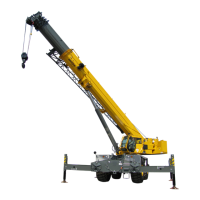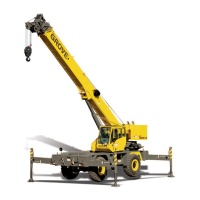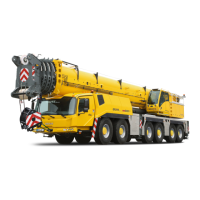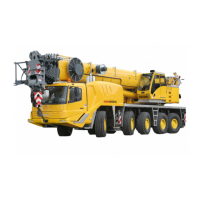OPERATING CONTROLS AND PROCEDURES RT770E OPERATOR MANUAL
3-30 Published 04-04-2017, Control # 446-09
• Conduct all travel with the assistance of a ground person
to warn the operator of any changing conditions in the
terrain being traversed.
Traveling on Slopes
Crane operators need to exercise caution whenever
operating the crane on uneven surfaces. Travel on slopes is
permitted if the following conditions are met.
• Do not exceed a 15% (8.5°) slope side-to-side or fore-
and-aft.
• Travel must be on an improved surface or on hard-
packed dry earth having a minimum 0.5 coefficient of
adhesion.
• Limit travel to a forward direction only.
• Do not exceed a speed of 1.6 km/h (1 mph).
• Fully retract all boom sections.
• Stow or remove the boom extension from the crane.
• Lower the boom to horizontal and position over the front
of the crane.
• Engage the swing brake and turntable lock pin.
• Either the hook block may be reeved over the main
boom nose or the headache ball may be reeved over the
main boom nose or auxiliary boom nose; the other must
be removed. If the hook block or headache ball remains
reeved on the boom, it must be secured at the tie down
on the carrier to prevent swinging.
• Inflate tires to the recommended pressure for pick and
carry operations.
• Ensure the hydraulic tank is filled to the specified level.
Ensure the fuel tank is over half full.
• Do not support any loads by the boom (i.e., no pick and
carry loads) while traversing a slope.
• Remove all cribbing or other non-standard accessories
from the crane.
• Avoid holes, rocks, extremely soft surfaces, and any
other obstacles that might subject the crane to undue
stresses and possible overturn.
• Conduct all travel with the assistance of a ground person
to warn the operator of any changing conditions in the
terrain being traversed.
The owner/lessee must take appropriate measures to
ensure that all persons operating or working with the affected
models are in compliance with The Manitowoc Company,
Inc. recommendations. The operator of the crane assumes
responsibility for determining the suitability of traveling on a
slope. Traveling on a slope should only be attempted under
the controlled conditions specified in these guidelines, and
must be conducted with the utmost diligence and care to
ensure the safety of all personnel performing the operation
and/or working around the crane.
Should the operator need to traverse slopes outside the
criteria defined in the above guidelines contact The
Manitowoc Company, Inc. for further guidance.
Traveling with Elevated Boom
Exercise caution whenever driving the crane with the boom
elevated. Travel with the boom elevated is permitted if the
following steps are followed:
• Limit travel to firm, level surfaces.
• Inspect the route of travel prior to moving the crane. Pay
particular attention to any changing conditions in the
terrain being traversed. Also, avoid any overhead
obstructions.
• Travel must be performed in a controlled fashion.
• Do not exceed a speed of 24 km/h (15 mph).
• Inflate tires to the recommended pressure for travel
operations.
• When using the towing attachments, the boom must
remain horizontal.
• Fully retract all boom sections.
• Refer to Traveling with Boom Extension and/or Inserts
Erected, page 3-31 if the boom extension is in the
erected position.
• Position the boom over the front of the crane.
• Engage the swing brake and turntable lock pin.
• The hook block may be reeved over the main boom
nose. The headache ball may be reeved over the main
boom nose or auxiliary boom nose. The block and ball
may be suspended below the boom nose. It is also
acceptable to secure the block or the ball to the tie down
point on the carrier to prevent swinging if necessary.
• Limit boom angle to a maximum of 20°.
• Do not support any load from the boom (see Pick and
Carry Load chart for limitations for this application).
WARNING
Overhead Objects Hazard
Contacting overhead objects while driving the crane may
result in death, severe injury, and/or equipment damage.
Traveling with the boom elevated should only be
attempted under the controlled conditions specified in this
section.
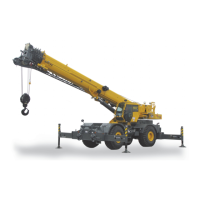
